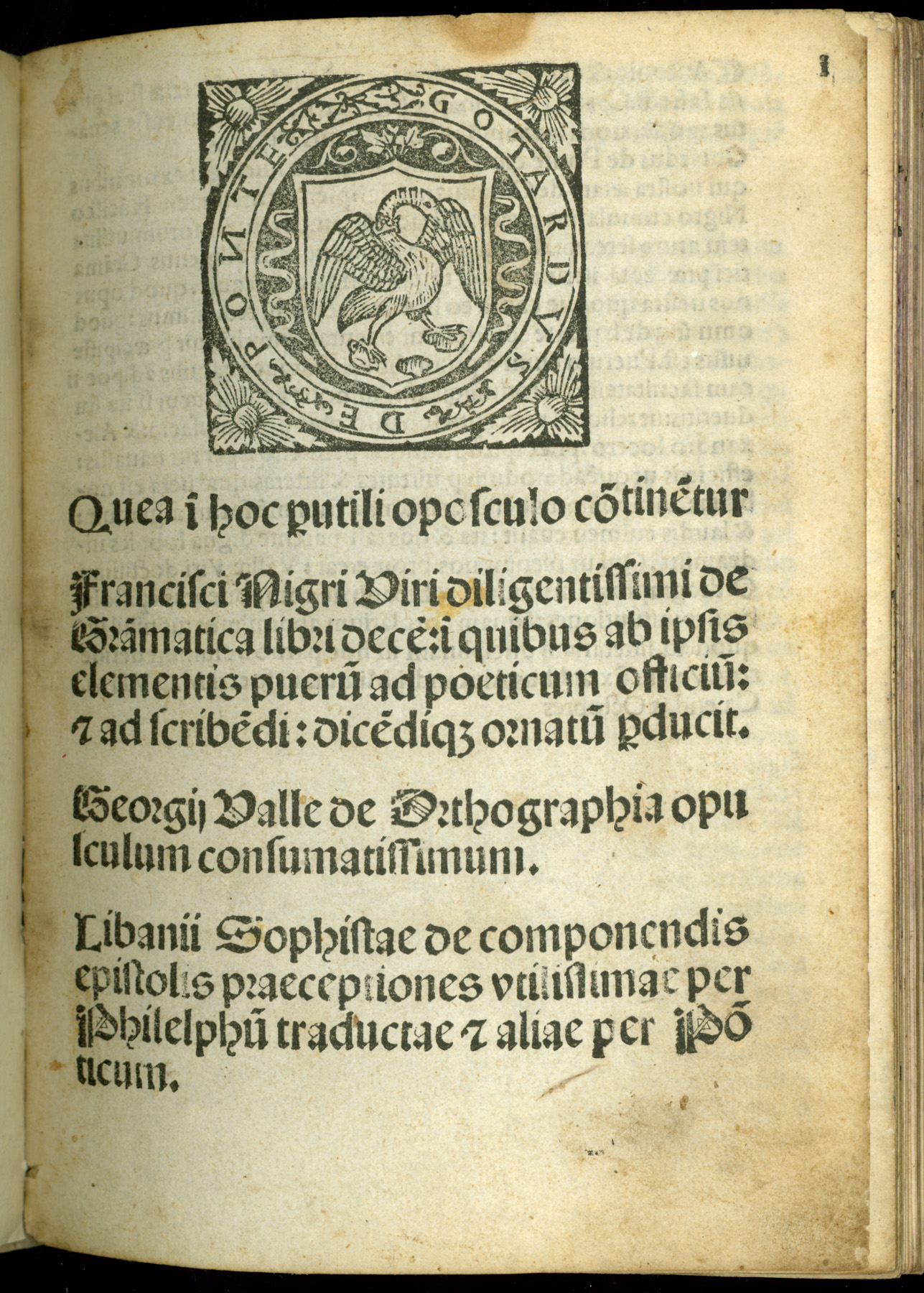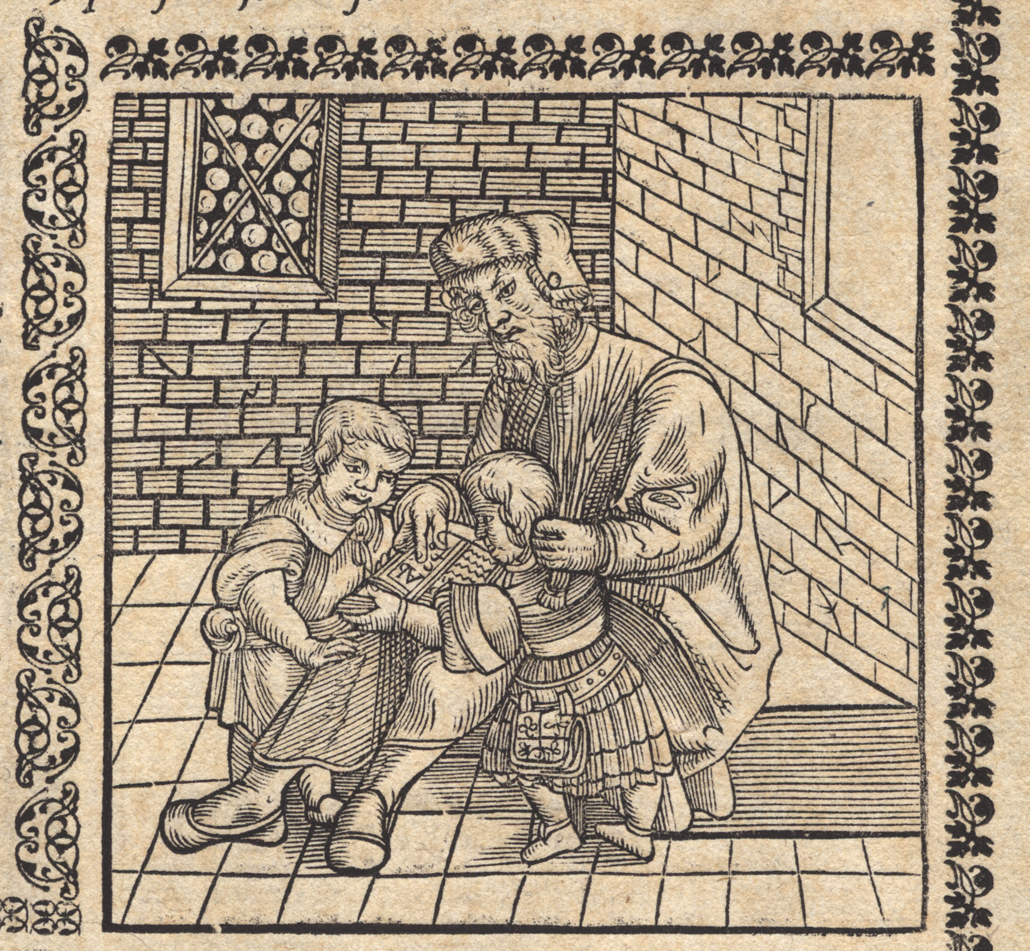0.07 The Case of Francesco Negro
The potential of such sources to give us useful clues may be clearer if we listen briefly to the authorial, editorial, and pedagogical voices present in one modestly successful Latin grammar, that of Pescennio Francesco Negro (1452 - ca. 1523). Negro was an influential author. His Forms of Letter-Writing was published repeatedly in Italy and in Germany, France, the Low Countries, and Spain. His more basic schoolbook, Ten Chapters On Grammar, had more modest success both North and South of the Alps. (37)

There is rarely anything really new in grammar, obviously, but teachers did make use of print to embody their own teaching methods, and their promoters almost always claimed innovations even when there were none. (38) The marketers of a 1508 Milan edition of Negro's grammar included a successful commercial printer, Gottardo da Ponte, and a printer/publisher, Leonardo Vegio, whose name appears on many humanist textbooks. Vegio gave his public an unusual amount of specific, flattering information about Negro in the conventional humanist form of a letter to the young son of a wealthy and powerful patron. Vegio started by naming the present Milanese printer, a locally recognized figure:
Since Gottardo da Ponte, citizen of Milan, well knows that among all those who have written on Latin grammar in our day none is more renowned than Francesco Negro, he [Da Ponte] has again contracted to us for printing the highly useful Grammatical Precepts at a distance of twenty-eight years from its first careful edition. ... This book leads a boy from the very cradle of letters all the way to poetic mastery and to the high point of oratory. If you study it well and work hard at it ... you will have progressed as it were in both virtue and letters, which is true nobility. (39)
Despite the humanist veneer, this is pure advertising. It was no small claim to say that Negro was the most famous grammarian of his age, especially since his reputation was in fact waning by 1508. Moreover, the exaggerated commonplaces commending the book also contain specific claims that it contains a comprehensive course. The detail that it was printed twenty-eight years back might seem to imply that it has been out of print for all the intervening years, but in fact there were at least four editions outside of Italy between the first printing of 1480 and this one, and it had appeared at Milan just a year earlier from Vegio's own press with a preface closely similar to this one. Vegio was making a different, and perhaps riskier claim, that he was setting out to remedy the book's relative absence from the market despite its author's fame.
The preface indulged another humanist motif we will see repeatedly, that the book was being produced in the present moment for the use of a single, well-born student. This commonplace evoked the ideal that humanists worked as private tutors to great aristocratic families and composed their textbooks for a few beloved students. But Vegio's preface also made the more printerly claim that this textbook can accompany any student from his first study of letters to finished eloquence in poetry and prose. The publisher seems to vacillate between saying that the book was a good old-fashioned one, thus admitting that it might be a bit passé, and claiming that it merited a large market for its broad scope and erudition.
So much for the publisher's foreword. The book is also dressed up with a fulsome preface and an equally wordy afterword by the author. By contrast to his unapologetic promoters, Negro himself affected the affable humility and patience of a good Christian humanist. He also assumed that the field of grammar was nastily competitive. These themes, which follow ancient and medieval models, would remain characteristic of printed grammars. (40) The 1508 author's preface was lifted from the first edition of 1480, so it is a print product; but it was in the form of a pre-publication letter to a noble patron, a Milanese ambassador to Venice. The voice was presented as somehow timeless, and yet it addresses very present-day issues of marketing:
Therefore I decided to send to you, excellent man, a brief work of grammar which I recently wrote but which has not yet been disseminated widely. And this is the reason I took up this work: not because I imagined that it would be praised as superior to what has already been written in this field of study by the ancients, or so that I would be compared to them, and even less that anyone should say that I have added anything. For I do not have such temerity or boldness. Rather it was for love of you ... to whom I am indebted. For I recalled to myself how much boys worry their studies at this age. (41)
To this oft-repeated theme of the teacher's compassion for students who had difficulty learning Latin, Negro added an equally conventional concern for the next generation, in this case for his addressee's sons.
Tropes of parental piety and of the teacher acting in loco parentis were more or less obligatory in humanist pedagogical prefaces. Negro went on, however, to anticipate criticism for his ambition and for the success of his work on the market:
I have collected into a single brief work all the flowers of the humanities, and I have mapped out a very short road by which a man may easily acquire them, so that he can become learned. But there will be some, perhaps, who will try to denigrate our work, especially since we have stirred up old detractors before its publication and will have acquired new ones as well, all of them, we judge, acting like a swarm of midges who think they can bite an elephant. Let those who would pester our writings be exhorted, however, to read first and attack later. For although there may not be learning enough in me, nor yet a complete understanding of the material (which is perhaps necessary), still that sentiment may apply to me which we read of Apelles in respect to Alexander and of Phidias in respect to Olympian Jove, namely we find that greater praise resulted the greater were those whose models they imitated. (42)

Prefaces at the turn of the sixteenth century often read this way, alternating humanist commonplaces of humility, altruism, and disdain for adversaries with specific marketing claims. Prefatory letters were intended as examples of classicizing prose; but we must also remember to read them as advertisements for printed products. The authors feigned respect for certain conventions of the manuscript age, but they were equally aware of the public for printed works. (43) Among teachers in particular it was important to sound learned and avuncular even as claims were made for exciting new classroom techniques or for the best old-fashioned ones.
NOTES
- Open Bibliography
- (37) For a partial list of editions, see the Bibliography; see also Mercati 1939, 24-109; Jensen 2001, 115. The grammar appears in shop inventories as late as 1594; see Archivio di Stato di Milano, Notarile Carlo Matteo Bonamone, 15 Feb. 1594. f. 19696, cited by Stevens 1992, 411-412. I am grateful to Professor Stevens for many kindnesses, including sharing a copy of this important inventory of the Antoni firm, which had the most extensive offering of grammar books documented for sixteenth century Italy. Compare Ganda 1988, 129 for Negro in the stock of Nicolò Gorgonzola in 1536.
- (38) Worstbrock 2001, 59-64; Jensen 2001, 103-105.
- (39) Negro 1508, A1r: Gotardus de Ponte civis Mediolanensis: cum intelligat ex omnibus qui nostra aetate de Grammatica scripserunt; neminem Francisco Nigro cumulatius praecepisse: ad communem studiosorum utilitatem anno fere .viii.&.xx. a prima aeditione tam diligentis Grammatici praecepta iterum nobis imprimenda oblocavit. ... Puerum enim a primis litterarum incunabulis ad poeticam facultatem; oratoriumque fastigiumque perducit: cui si ita studueritis; ut reliquis preceptis sub viro optimo Bonifacio & Alexandro socero: praeceptore nunquam penitendo operam navastis; efficietis ut quemadmodum per virtutes et literras: quae vera est nobilitas.
- (40) Munzi 1994, 110-116. See also the prefaces of Lucio Giovanni Scoppa (d. ca. 1551) as explicated by Fuiano 1971, 42-48, that of Bonisoli 1474, and that of Barzizius 1492, reprinted in Querini 1739, 15-17.
- (41) Negro 1508, A2r-v: Grammatices ergo per breve opusculum nuper a me ortum: adhucque non bene vagituum oblitum ad te vir praestantissime mittere decrevi. Hunc namque laborem suscepi: non quia laus superque a priscis auctoribus in tali scientia scriptum fuisse diffiderem: meque uel illis aequare: uel quae minus sufficienter dicta essent: addere uellem. Non enim tanta in me temeritas uel audacia: Sed summo in te affectus amore ... cui ego & debitus sum ... Cum mecum ipse cogitassem: quanto adolecentuli labore hac tempestate insudant.
- (42) Negro 1508, A2v: ... breviter omnes humanitatis flores in unum corpus redegi: mostravique viam brevissimam qua illos facillime capere: & in doctum virum evadere possit. Sed non deerunt fortasse qui scriptis nostris detrahere conentur: cum presertim ante operis editionem veteres suscitaverimus: novos quoque acquisiverimus obtrectatores: quos tanti faciendos esse censemus: quanti culicum barri aestimant morsus. Illos autem exoratos velim qui scripta nostra fastidiunt ut prius legant: deinde vituperent. Nam licet in me non sit doctrina sufficiens: non rerum cognitio plena: qua forte opus esset: illud tamen mihi fortasse continget: quod Apelli in Alexandro: Phydiaeque in olympio Iove contigisse lectitamus, quos tanto maiore fuisse laude comperimus: quanto praestantiores formae fuere: quorum archetypa sunt imitati.
- (43) Munzi 1994, 106-107; Farenga 1994, 64-65; Rummel 1995, 41; Jones 2004, 196-198.